Popenguine, the ‘Lourdes’ of Senegal.
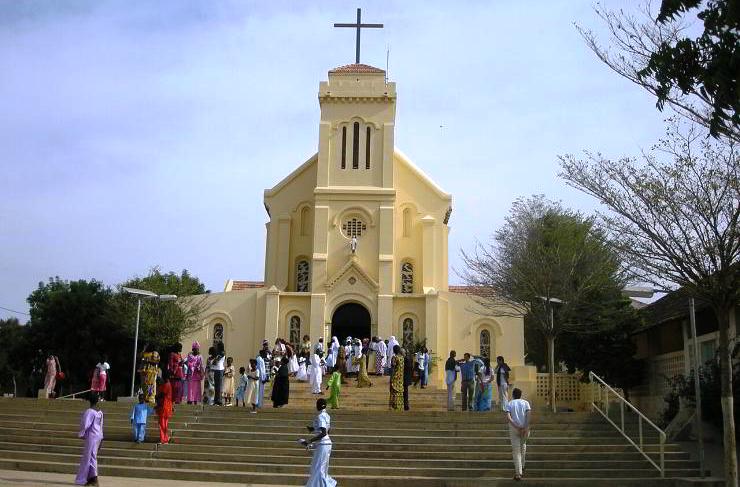
On Pentecost Tuesday, 22 May 1888, a crowd of two hundred faithful arrived at the sanctuary of Popenguine on foot, on horseback and in pirogues to venerate Our Lady of Deliverance for the first time. Over more than a century, this pilgrimage, which now attracts nearly 100,000 people each year, has become one of the high points of the Christian faith in Senegal. We joined the pilgrimage.
The beginnings of the Marian pilgrimage to Popenguine can be traced back to the evening of 29 December 1887. A few months earlier, on 15 May, Bishop Mathurin Picarda wrote to his faithful: “The purpose of this pilgrimage, which we hope will open a series of manifestations of faith and devotion towards Notre Dame de la Délivrance (Our Lady of Deliverance), is to solemnly enthrone the Virgin in the new domain we have chosen for her.”
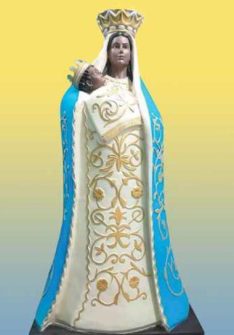
The statue of Notre-Dame de la Délivrande. Photo: Sr. Anne Béatrice Faye.
Although there had never been an apparition of the Virgin Mary, Monsignor Picarda wanted to offer Senegalese Catholics a place of pilgrimage, inspired by the shrine of Notre-Dame de la Délivrance in Dover, Normandy, France.
The idea was born during a walk with priests, members of his congregation, from Cap de Naze to Popenguine. The place seemed providential: Popenguine means “head of the serpent”, recalling the mission of Mary, who, according to Christian tradition, crushed the head of the serpent. This place of divine grace is deeply rooted in faith and spirituality. Although specific testimonies of healing are not always documented in detail in the available sources, this shrine is known as a place where pilgrims come to seek comfort, to be listened to, and a place of hope and healing.
Notre-Dame de la Délivrance gradually became Notre-Dame de Popenguine, and every Pentecost Monday, crowds of the faithful flock there to pray to the Virgin.
Rooted in young people’s faith
The youth pilgrimage to Popenguine is a tradition deeply rooted in the Senegalese Catholic faith. Every year, thousands of young people from the various dioceses in Senegal take part in this walk of faith, covering dozens of kilometres in a spirit of prayer, sacrifice and solidarity.
The young people’s walk to Popenguine is an experience that goes far beyond a simple physical pilgrimage. It is a spiritual journey where every step is an offering, every effort a prayer. The testimonies of the pilgrims reveal just how powerful this experience is.
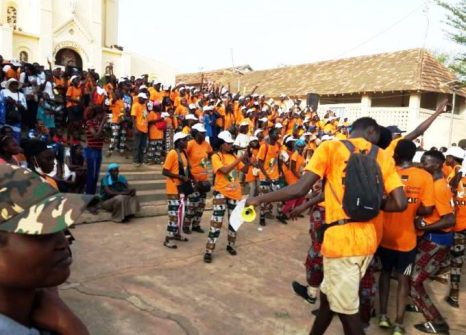
The youth pilgrimage to Popenguine is a tradition deeply rooted in the Senegalese Catholic faith. Photo: Ji-Elle
Many describe it as an inner transformation, healing and soothing of their spiritual or emotional wounds, which takes place as the walk progresses. Walking becomes an opportunity for reconciliation with themselves, with God and with others.
For each young person, arriving at the Popenguine shrine is a moment of grace. After hours, or even days, of walking, the pilgrims find themselves before the Virgin Mary, in a burst of thanksgiving. It is a moment of intense emotion, where tears, joy and prayer mingle. Each person arrives with his or her spiritual baggage, intentions and fatigue, but all leave renewed in faith and buoyed by new hope. The walk to Popenguine becomes not just a geographical journey, but a true inner pilgrimage, a journey to God, experienced in effort, fraternity and prayer.
Interfaith dialogue
The Popenguine pilgrimage is not merely a Christian spiritual experience. It is also a symbol of inter-religious dialogue as is practised in Senegal. The presence of Muslims in Popenguine is not anecdotal, it is a living sign of a Senegal where religious diversity is seen as an asset rather than an obstacle.
Every year, many Muslims take part in the Popenguine pilgrimage. Some come with friends or members of their Christian families, sharing their spiritual journey with kindness and openness.
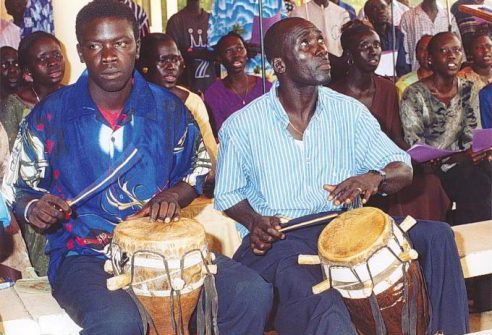
The choir during the celebration of the Eucharist in the Shrine. Photo: Ji-Elle
Others come out of respect for the figure of Mary, venerated in Islam as the mother of the Prophet Jesus (Issa), and regarded as a model of piety and submission to God. This shared recognition of Mary as a spiritual figure creates a bridge between the two faiths, fostering understanding and dialogue. Popenguine is also an opportunity for intense prayer for peace and unity in Senegal. In a world where inter-religious tensions are sometimes exacerbated, the pilgrimage becomes a powerful testimony to the possibility of harmonious coexistence. Far from being a simple Christian gathering, it unveils a space where all people of goodwill, whatever their religious affiliation, come together to invoke God’s blessing on the country and the world.
Moving experiences.
Thousands of believers come to Our Lady of Popenguine in search of grace, comfort and healing. Some come with inner wounds, others with physical pains or burdens they can no longer bear alone. All leave the shrine transformed, touched by the presence of God and the intercession of Mother Mary. We met some of the people at the Popenguine Shrine and shared their spiritual experiences with us.
Awa, a young Muslim woman, carried a deep family wound. An argument with her father had separated them for years. The pain of this separation never left her. During the pilgrimage, she felt an unexpected sense of peace. During the vigil, an inner voice urged her to reach out to her father. She sent him a message, something she had never dared to do before. Against all odds, he responded with emotion, ready to renew the dialogue. For Awa, this pilgrimage was an event of true reconciliation and unexpected grace.
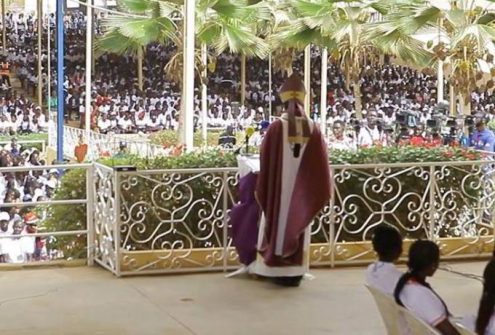
Mass with the Bishop in the Shrine. Popenguine is also an opportunity for intense prayer for peace and unity in Senegal. Photo: Ji-Elle
John the Baptist, a young university graduate, was going through a period of doubt and discouragement after three years of fruitless job hunting. Before the pilgrimage, he had almost given up hope. So, he entrusted his future to Mary and decided to entrust his fears and uncertainties to her. When he returned home a week later, he received a call for an interview at a company where he had been applying for several months. Against all odds, he was hired. For him, this opportunity was an answer to his prayers and proof that hope is never in vain.
Madeleine and her husband had lost their child a few months before the pilgrimage. Devastated, they came to Popenguine with heavy hearts and full of questions. During the procession and the moments of silence before the statue of Mother Mary, they felt a deep sense of peace and renewal of their faith. Madeleine said that for the first time since the tragedy, she was able to say: “Lord, I don’t understand, but I trust you.
Finally, Popenguine is a living shrine of faith and hope. Many visitors experience the power of faith, healing and consolation. Under the benevolent gaze of Mother Mary, they leave the Shrine with the certainty that God continues to work in the hearts of those who entrust themselves to Him. May Mother Mary continue to accompany her children on their journey of faith and hope. (Open Photo: Senegal. The shrine of Notre Dame de la Délivrande in the town of Popenguine. (Photo: Ji-Elle)
Sr. Anne Béatrice Faye, CIC.



